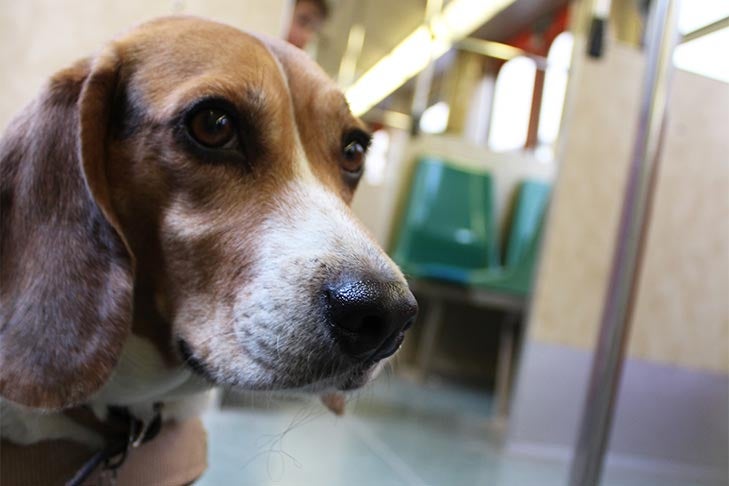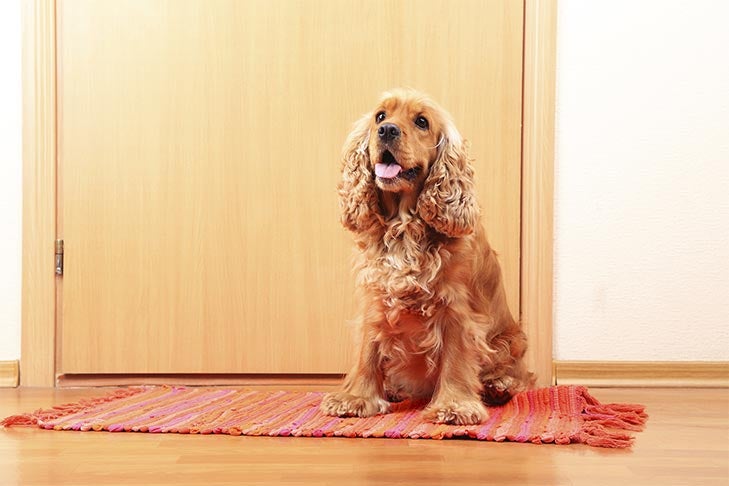As natural disasters become more common, it’s important to plan ahead in case you and your dog need to someday evacuate your home.
One aspect of being prepared for a possible evacuation in the event of a natural disaster involves having things physically ready like making sure your dog is microchipped, preparing “go bags” for your dogs that include proof of vaccinations, dog food, treats, toys, collar/harness and leash, updated ID tags on your dog’s collar, and any medication that your dog needs.
Equally important is developing a training plan in advance to work with your dog to make sure that if an evacuation ever needed to happen your dog will have the skills to remain calm and focused on you so that you can put your attention on the emergency and not your dog’s behavior.
Ideally, you’ll have some warning and be able to self-evacuate to a pet-friendly hotel or stay with friends or family outside of the danger area. If not, the American Red Cross and other local groups will be able to support you with finding access to a dog-friendly evacuation option. In some instances, you will be able to provide care for your dog yourself, but in other instances, dogs will be housed separately from their owners.

Evacuation Training Skills For Your Dog
Friendly Stranger
Some dogs are nervous or uncomfortable around people outside the immediate family, which can make things extra. Being comfortable being led away or being with a friendly stranger is something that is very challenging for some dogs, but it’s a skill that is really important for all dogs to have, especially in an emergency situation. Practicing this skill in advance will help make being cared for by a stranger much less stressful for your dog in the event you needed to evacuate.
Training Tips
- If you and your dog or puppy attend obedience classes, ask your instructor or a fellow student to watch your dog while you go to the car to get something or run to the bathroom.
- You can also practice this skill with friends and family members at home and at pet stores. Ask these individuals to give your dog treats, or play with your dog for a few minutes as you leave the area.
- When you return, stay calm, and similarly to how when you get home, avoid making an over-the-top fuss over your dog.
Practicing this skill regularly will help your dog be more comfortable if they need to be cared for by someone other than you in the event of an emergency. In addition, being able to calmly stay with a friendly stranger is one component of the AKC Canine Good Citizen Testing.
Familiarity with Distractions and Crate
Natural disasters are overwhelming, chaotic, and stressful for people and dogs. To help prepare your dog for being able to follow cues from you during a stressful evacuation situation, make a regular practice of working with your dog not just at home but out in the world. It will be important to make sure your dog is comfortable being in their crate.
Training Tips
- To introduce your dog to the crate, toss some treats into the crate, and when your dog goes in to get the treat, praise. Keep the crate open and when your dog comes out toss another treat out and repeat. We want to teach our dogs that going into the crate means something good (treats) happens.
- As your dog gets more familiar with the game, they will start to offer to go into the crate on their own, when they do toss treats into the crate once their inside. At this point, you can start to close the door for a few seconds, toss treats into the crate, open the door, and treat again while your dog is still in the crate so your dog continues to build positive associations.
- You can start to slowly build up the length of time your dog is able to be in the crate starting from just a few seconds, to then a few minutes at a time.
- Giving your dog an appropriately sized durable, rubber toy stuffed with treats, kibble, or peanut butter and frozen can be helpful. These safe chews give your dog something to occupy their mind while in the crate and can support your dog relaxing while crated as you build the duration.
- Keep your dog’s crate in a quiet part of your home where your dog can retreat for some alone time, but also incorporate the crate into your regular activities with your dog. Play games with the crate by hiding treats or toys in the crate for your dog to find. You can also feed your dog meals in their crate to build additional value and positive associations with crating.
Note: A dog shouldn’t be left for long periods of time in a crate. Dogs who are comfortable in their crates should at max be crated for four to six hours and less for puppies.
Settle
having an “off switch” and being able to settle/relax and relax lying next to you is a helpful skill that all dogs can benefit from, and will be very useful if your family experiences a natural disaster and needs to evacuate. With “settle” your dog will know to relax at your feet while you are able to focus on talking to someone, filling out paperwork, etc.

Teaching Settle:
- To teach begin at home in a low-distraction environment.
- Have your dog leashed to you and lots of small treats on hand. Your dog’s kibble works well for this, so you could work on teaching this skill at mealtime.
- Ask your dog to “down” (or lure them into a down position with a treat) and when they do calmly praise and give a treat. While your dog is down keep praising and giving kibble.
- When your dog gets up don’t say anything just stop giving treats.
- For a couple of repetitions ask your dog to down and repeat the above steps of calmly praising and giving treats while your dog is in a down position.
- This is a time you can start to add in a verbal cue of your choice like “settle” or “relax”
- At this time you can begin to vary the frequency that you treat your dog as they remain in the settled position, and increase the length of time you ask your dog to settle for before giving your release word.
- The more familiar with the skill your dog gets, you can begin to work on this skill in more distracting environments like your backyard or on your front porch, the sidewalk, and build up slowly to more distracting environments like settling while you talk to someone, settling while in a park, in pet-friendly stores, etc. The more experience you can give your dog practicing settle in distracting environments, the better prepared you and your dog will be for using this skill in an emergency.
- Over time, your dog laying calmly and waiting next to you will become a default behavior when you stop while out walking or in the yard, which is the ultimate goal.
Place
An advanced version of the above settle skill is “place training.” For this skill dogs will be able to calmly settle on a bed, blanket, towel, etc. near but not always directly next to the owner. There may be times when you need your dog to be relaxed and stay but not right next to you, especially in the case of an evacuation, so the ability for your dog to calmly settle on a bed or blanket away from you is essential.
Teaching Place:
You can use anything for this: a raised dog bed or low training platform, but you can also use a dog bed, a blanket, or a towel. In the event of an emergency evacuation, you may not have access to all of your preferred training supplies, so start by teaching this skill using a variety of options including a bed, a blanket, and bathmats (these are ideal because the non-slip backs help them not to move when dogs go to them). Start this activity in a quiet area with minimal distractions.
- Lure your dog to the mat or bed with a treat and tell them to down or lure them into a down.
- Follow the above “settle” instructions for rewarding your dog for being on the bed/matt – the goal is to build value in this location
- After several repetitions, add in a verbal cue of your choice, such as “place” or “bed.”
- Begin to phase out your lure to the mat/bed, and at first, stand next to the mat use your cue to ask your dog to go to it, when they do, treat and praise. If your dog doesn’t “place,” it just means they don’t quite understand yet and you’ll need to lure them a few more times before moving to this step.
- Now we want to continue to reinforce duration, so similar to how you worked on “settle,” keep praising and giving small bits of treats (or kibble) while your dog remains down. The goal isn’t to force your dog to stay in a formal down, but rather to reinforce and build value in being relaxed in a specific location.
- You can now begin to send your dog to “place” from a bit further away and then come in to reward, then walk away, going back and forth to praise and treat as your dog settles on the bed/mat.
- At this point, you can begin to vary the frequency that you treat your dog as they remain in the settled position and increase the length of time you ask your dog to settle before giving your release word.
- If it’s safe to do so, you can also practice with your dog tethered by a short 4- to 6-foot leash (this should only be done with full supervision). The tether isn’t to force the dog to stay in place, but rather an emergency backup in case your dog gets up as you are across a room or a short distance from your dog when outside.
While none of us like to think that we could ever be forced to evacuate our homes it’s important to be prepared for the possibility. If a natural disaster strikes your area, advanced prep and helping your dog to learn skills that will help reduce stress for both of you during this challenging time.

